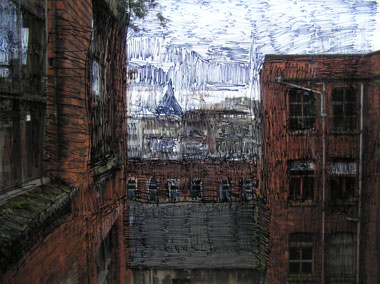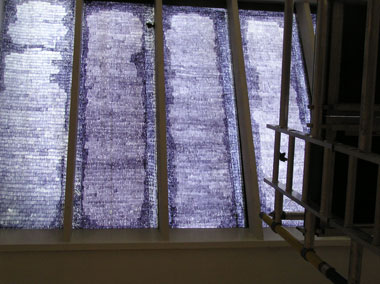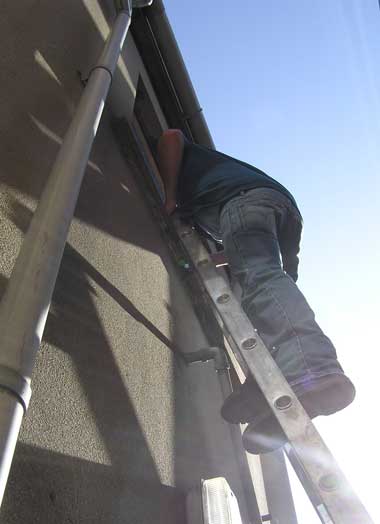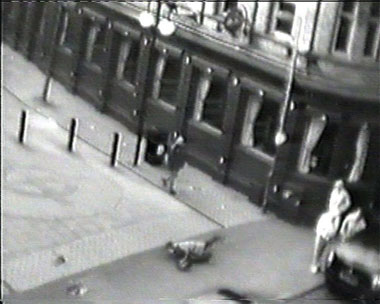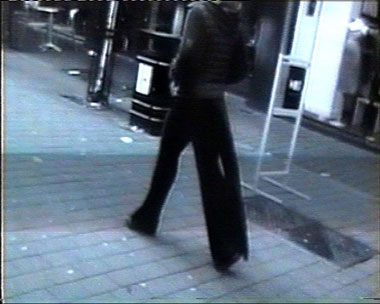An exhibition, Proving the existence of black holes in everyday life (Old Museum Arts Centre, Belfast, 28 November 2006 – 6 Jan 2007), inspired the following e-mail conversation between Slavka Sverakova and Fiona Larkin.
Slavka Sverakova: Contrary to popular myth, a black hole is not a cosmic vacuum cleaner. It is made of the stuff that is left after the collapse of a large burnt-out star in the so called scalar field that knows two forces only: gravity produced by itself and its own pressure. Taking it as an analogy to art – what two forces would you name as precondition for ‘black holes’ in everyday life? What two artistic strategies you think of in relation to these?
Fiona Larkin: Pressure is a good word. Pressure from within and imagined pressure from outside which seem to produce isolation, fear and above all fear of others. I had considered these things as creating a kind of atmosphere within which insularity appears the safest option.
SS: Your selection of fear as the force that modifies existence is fully validated by the practical life of people and animals, as well by scholarship on behavioral patterns. Fear signals danger, signals flight or fight. You point out that “isolation" is the safest option. In some social and political systems this led to inner emigration, if not actual emigration. Artists often preferred the inner emigration on ethical grounds. Authenticity and self-respect guided those choices, even if the consequences were quite dire. I think of Vaclav Havel’s three years in jail, for example. That I think is pressure – it seems that in some situations isolation replaces one pressure by another, directed against the Self. Maybe the “isolation" you have in mind is a more aggressive kind – hierarchical even, and crucially, directed against the other.
FL: Yes, the kind of pressure I referred to in I wouldn’t give them the light of day did grow out of a concern or fascination with behavioral patterns. I wondered what prompts us to set ourselves apart even in our everyday vernacular. I also wondered what lengths we are prepared to go to, to regulate and control our surroundings in order to lessen contact with “them.” To some degree this is less severe than the kind of isolation you point to; perhaps it is more like ring-fencing. In The lengths some people go to (the scaffolding and skylight), I hoped to point at the absurdity of this kind of self-regulation. Havel said that he recommends a sense of humour and “ an ability to see things in their ridiculous and absurd dimensions, to laugh at others and at ourselves,” I did feel a little ridiculous perched up there, invisible…and colouring in my bathroom window…
SS: The last point is a welcome example of the power of aesthetic categories turning into their opposites: your feeling of the comical while working produced video images that are not ridiculous or comical, but sublime and beautiful before the image turns into tragic black – maybe a black hole. I’d like to extend this: the categories of power and control cannot grasp the “imperative of life optimisation” except in art.
FL: Yes, considering this idea of things becoming reversed, if, as Beuys suggests, “art is the science of freedom,” then I did sense schism between the subject matter and art as a means when making the work. With that in mind, I turned to simple, maybe crude methods to explore effacement and envisage this fear – a thick black permanent marker and the act of blocking things out. I overlaid this method of working on everyday events such as making tea, drawing the curtains…in an attempt to grasp how the fear of the unknown might shadow these acts .
SS: Yes, effacement and envisaging or visualising a state of mind by doing a multitude of ordinary daily chores, are types of replacement of fear by a perceived safety of predictable outcomes. Yet in the installation not all was that predictable. The elements of inappropriate collaboration of the sparkling new scaffolding inside a room finished long ago, the scale of the construction with a ladder attached, the video monitor on one of the platforms, the insubstantial, smoke-like black marks on the skylight, coerced the feelings of wishing to take part and being afraid to do so. That was a perceivable might, unknown in its impact. For me, it analyzed my concept of freedom in those conditions. At the end, I did not participate by climbing up, as you did. I only looked, observed, imagined… Your artwork thus became a means for testing – like a scientific instrument.
FL: I appreciate the temptation the scaffolding offers; the fact that it prompts you to think of scientific testing is significant, considering that I was concerned with our attempts to conquer fear of others through controlled environments. In the sense that it offers a chance to take part and prompts action, it is a test. The decision to expose the making of the work through leaving the scaffolding was intended to point to the extreme lengths pursued to create division. That the scaffolding belongs to the world of work was also important; this is a nod to the public face of constructing isolation that often surmounts the individual.
SS: It is impossible to see a black hole directly or escape from it. Your title of one of the works in the exhibition closely parallels this: .”.. wouldn’t give them the light of the day" – as a saying, a turn of the phrase, it feels antagonistic, negative, dismissive of the Other. This may be analogous with being sucked into a black hole when the Schwarzschild radius is being crossed, where escape speed equals speed of light and once light passes through, even it cannot escape. I was impressed by the fragile beauty of that video – and how it moved itself from high-key pleasant colours into the terminal darkness. The rhythm you chose, a kind of staccato conducted by the frames, invited another analogy with black holes: there is a special critical initial strength, such that the scalar field cannot decide whether to evaporate away or collapse to form a black hole. Instead it oscillates; in the first evolution it doesn’t form a black hole, in the second it does. The oscillation is there in the video. Is it also somewhere else?
FL: The title is a quote from a BBC radio interview with a woman from Belfast discussing how she felt about her neighbours. I was interested that such an ordinary saying proposes the impossible. Light is a given, though no light escapes from thinking this way, that is a black hole of sorts. The oscillation you mention occurs somewhere between being aware and not wanting to know.
The act of blackening the window works like a period of mourning – the determination not to see further, to know only what is in front of your nose; however, in carrying out this sort of strange act you begin to know more regardless. Things are reflected, you are reflected in the black, things outside appear highlighted and not hidden.
The speed or rhythm occurs by way of stop-gap, requiring compulsive recording of every other mark made on the bathroom window…so it is the rhythm of an obsessive maker! This hints also at a kind of determination, not being sucked in but choosing .
SS: This is an important paradox of freedom – we may make a choice at times, at other times the choice is not given or is so difficult that we do not attempt it; we cannot will things to be. You covered the skylight with black marks – could a link to the paths of photons at the formation of black hole be a valid comparison? What in everyday life you perceive as pathways? A ‘lingering sense’ of something, perhaps?
FL: Truthfully I know nothing about photons! To some extent, I have ‘magpied’ science and forged my own connections and in this mode picked up New Scientist some months ago to read that looking at the night sky “you may actually be surveying the star-speckled interior of a five-dimensional black hole”[ 1 ]. The lengths some people go to seemed then to fit, a kind of site-specific, DIY black hole, and in its construction (the scaffolding, the time spent akin to that of a dedicated home maker) a connection with domesticity and work, thus actively forging a path to your own 5-D black hole.
The ‘lingering sense’ of not loving your neighbours relates again to the bathroom, when I looked at the window and thought about the act of tattooing curtains and blackening windows and how those outside would perceive this strange act……again you see yourself reflected in others.
SS: This appears like interference with the other’s attention, consciousness, aesthetic judgment as if without warning – I mean here that this is art outside an art institution. In the twentieth century, such a concept led to an anxious object – Warhol’s Brillo box is art, but if placed outside the gallery, it is a Brillo box. In your art practice I recognize a very different concept; the object in its nascent phase is a part of life, it is biological, biopolitical, bioaesthetic…like the work you submitted for the Perspective exhibition In the Ormeau Bath Gallery in 1998. You carried a bag with sand, adding more every time you needed to rest. Punishment? Reward?
FL: The Sandbagged arse, 1998, piece where I walked about Belfast wearing a kind of leatherette prosthesis was the first time I had considered using the street as a site for work. Orchestrating these interventions / actions offered a number of different possibilities – primarily, active involvement with members of the public, also a real context and a broader audience. The work was then transplanted in a fairly raw form to the gallery so that the gallery audience might have active involvement too.
I was exploring aspects of punishment and docility, but maybe guilt as punishment; again my interest in behaviour and control and self-regulation resounds.
SS: Louise Dompière, in her essay in the Perspective catalogue, pointed to three circular links: between gallery and street, between your body and the artwork, and between art and " its force that eventually brings us to sit down" – meaning the participatory audience. In a way, the photographic documentation of the walk with the bag of sand was a multiple portrait of the artist – you. Accepting that construct as the meaning of the work would crucially miss the far more important concept of benign intervention in normal life. I found that you use yourself as a tool most available, not as irreplaceable presence. After all, the latest work allows objects only to be visible .
FL: Yes, in the Black holes it seemed more poignant to adopt absence as a way of working and for my actions to remain insidiously in the background, suggested by the marks made and the scaffolding for example. The work had been moving in this direction for some time: in the more recent street interventions, 40 strangers, 2004, and Fall, 2003, the actions grew ever more subtle. Unlike The Sandbagged arse, these actions were more like an ordinary event than something being played out for our entertainment. With these later actions, on the surface there is nothing untoward, then monotony is transformed into something absurd.
For the most part the work is a gentle prodding at accepted social behaviour and addresses the notion of self-blending with cultural norms and the gaps that occur within the conventions of communication.
SS: 40 strangers is a kind of documentary that you edited very carefully. Let us stay with it for a moment: what, in editing, became the most helpful for the transformation you just mentioned?
FL: As the work was made through a complex choreography of two cameras, one hidden in my handbag, the other watching my awkward attempts to converse, the edited work needed to sync these two disjointed images. For the viewer this juncture between the images, though jarring at first, altered their experience of the conversation. The focal point became the irritated gestures, and the attempts to dissociate from the conversation by the strangers that I approached.
The sound was also key; though muffled, the question asked, “Where are you going to“ is ordinary and appears as a polite transgression when asked upfront to a complete stranger; some are affronted, some shrink away. The fact that it is none of my business and that it strikes as an intrusion serves to point at the ridiculous nature of the things we hold as private, considering that all of these strangers were filmed on public transport .
SS: Fall is slightly different in that it is you falling in front of passers-by and not taking a photograph – I see that as the first decision in the creative process. I am thinking of the lonely moment before you engage the other person or persons, the moment of emptiness, not knowing what they may do. I feel that it calls for courage which, for example, I do not have. Luckily, nothing untoward occurred throughout the making of it. In editing, I recall your acute concern about viewing angles – a problem the greatest of photographers speak of with respect. The aesthetic power of angles at which the lens records an event is in your case connected to a surprise or some such phenomena. Do you think of these as having transformatory power?
FL: Fall was recorded on CCTV cameras, offering a bird’s-eye view. The viewer is immediately elevated; this camera is in a sense privileged; however, it is also set apart and distanced. The camera angle has the suggestion of power and control; however, falling in the middle of a busy street shows a loss of control, and really what was at stake here was our attempts at self-surveillance in the public domain. What the cameras couldn’t access were the humane reactions of passers-by, most of whom offered help. The element of surprise serves to punctuate the rhythm of the street, it offers another focus.
SS: We have not discussed a number of your artworks, eg the one you made in the Belfast Tesco. And – help, please, I do not recall what TheTail is about.
FL: I carried this action out on Ash Wednesday in Belfast, a day when difference is marked. The Tail is simple and like The Sandbagged arse in that I set myself apart by wearing it; of course, most people found it funny, which I enjoyed!
SS: The loop between fear and humour became filled with pressure, surprise, commitment, inversion of the expected and accepted, while in all situations the provocation is forbidden to hurt and the intervention is commanded to stay ordinary. I think of such power of transformation as the sign of good art.
Slavka Sverakova is a writer on art.8

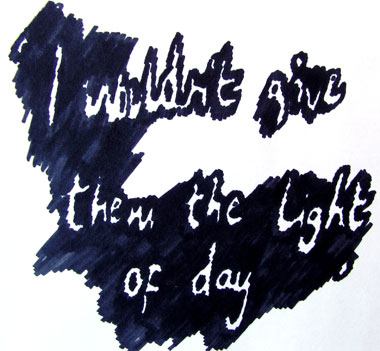
![Fiona Larkin: [from left to right] Your impression of them , Surrounded , What they say , Amongst others , Untitled ; all 2006; all Light Jet print on Diabond and drawing; courtesy the artist](/wp-content/from VAC/articles/2007/images/fionalarkin/Photos-OMAC,-Your-Impressio.jpg)

